Report on Implementing an Emergent Literacy Program for Young Children
VerifiedAdded on 2022/10/17
|12
|2882
|21
Report
AI Summary
This report details a two-week interest-based emergent literacy program implemented by a student with a group of five children aged 3-5. The program utilized the book 'Pig the Pug' and focused on activities aligned with the Australian Early Years Learning Framework (EYLF). The report outlines three learning experiences designed to enhance children's emergent literacy skills. The first activity involved initial book reading and comprehension exercises, using picture cutouts and toy sharing to reinforce understanding. The second experience focused on reading skills, with children identifying words starting with specific alphabets. The third activity emphasized writing skills, where children traced and wrote words using cotton swabs and pencils. The report analyzes each activity's rationale, its connection to EYLF outcomes, and the development of key literacy components such as reading comprehension, vocabulary, and writing skills. The project aimed to foster the children's confidence, communication, and engagement in learning.
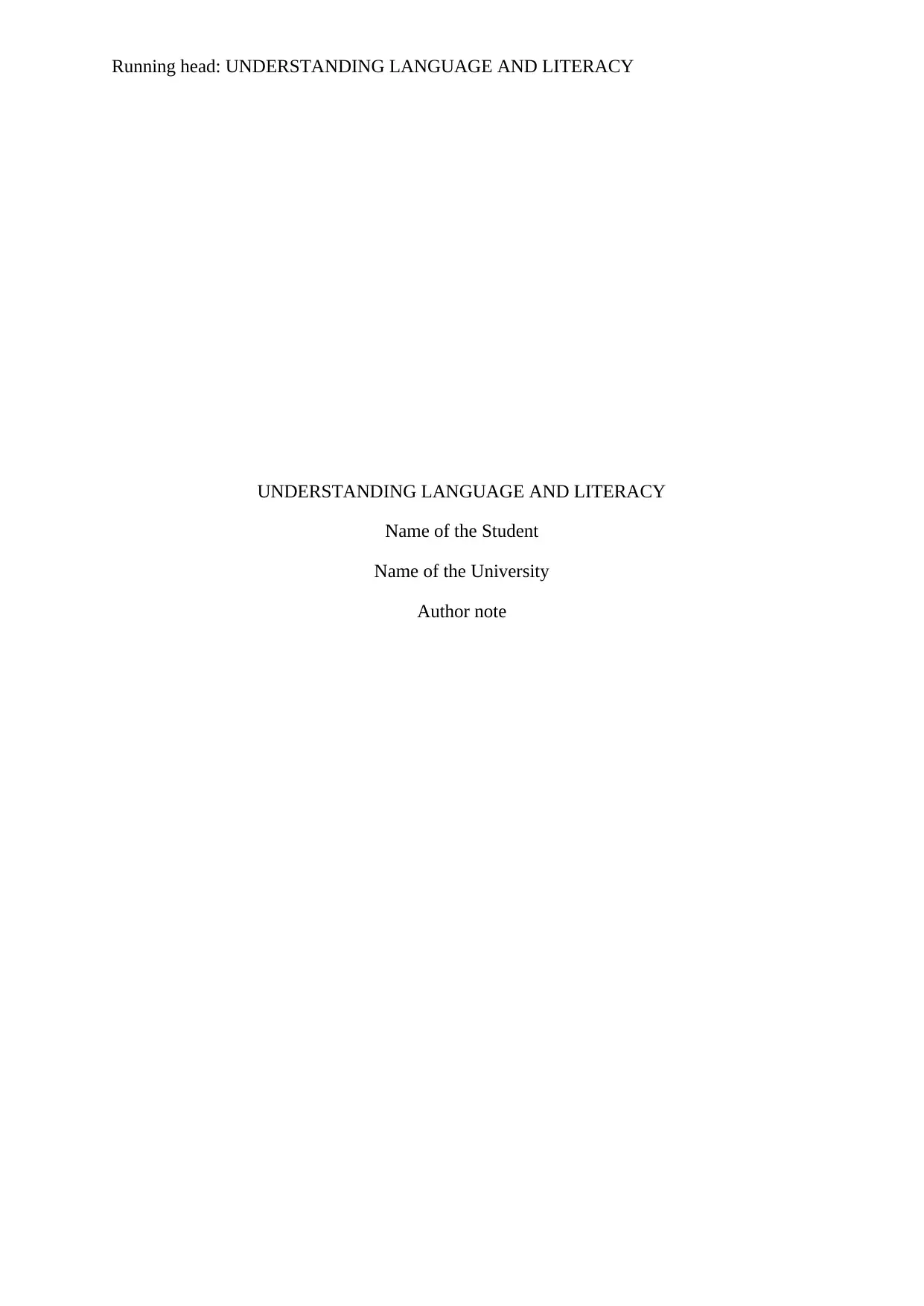
Running head: UNDERSTANDING LANGUAGE AND LITERACY
UNDERSTANDING LANGUAGE AND LITERACY
Name of the Student
Name of the University
Author note
UNDERSTANDING LANGUAGE AND LITERACY
Name of the Student
Name of the University
Author note
Paraphrase This Document
Need a fresh take? Get an instant paraphrase of this document with our AI Paraphraser
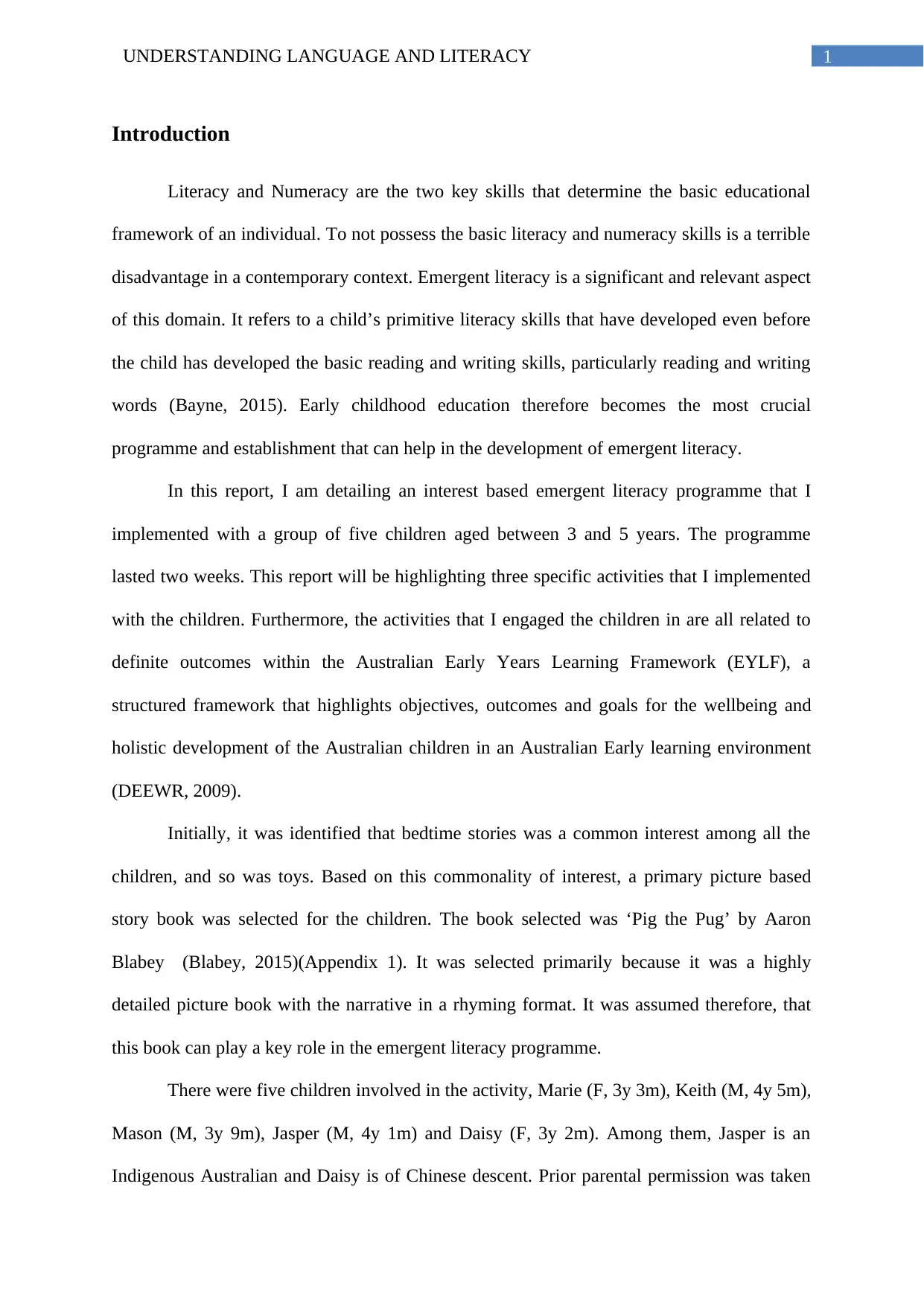
1UNDERSTANDING LANGUAGE AND LITERACY
Introduction
Literacy and Numeracy are the two key skills that determine the basic educational
framework of an individual. To not possess the basic literacy and numeracy skills is a terrible
disadvantage in a contemporary context. Emergent literacy is a significant and relevant aspect
of this domain. It refers to a child’s primitive literacy skills that have developed even before
the child has developed the basic reading and writing skills, particularly reading and writing
words (Bayne, 2015). Early childhood education therefore becomes the most crucial
programme and establishment that can help in the development of emergent literacy.
In this report, I am detailing an interest based emergent literacy programme that I
implemented with a group of five children aged between 3 and 5 years. The programme
lasted two weeks. This report will be highlighting three specific activities that I implemented
with the children. Furthermore, the activities that I engaged the children in are all related to
definite outcomes within the Australian Early Years Learning Framework (EYLF), a
structured framework that highlights objectives, outcomes and goals for the wellbeing and
holistic development of the Australian children in an Australian Early learning environment
(DEEWR, 2009).
Initially, it was identified that bedtime stories was a common interest among all the
children, and so was toys. Based on this commonality of interest, a primary picture based
story book was selected for the children. The book selected was ‘Pig the Pug’ by Aaron
Blabey (Blabey, 2015)(Appendix 1). It was selected primarily because it was a highly
detailed picture book with the narrative in a rhyming format. It was assumed therefore, that
this book can play a key role in the emergent literacy programme.
There were five children involved in the activity, Marie (F, 3y 3m), Keith (M, 4y 5m),
Mason (M, 3y 9m), Jasper (M, 4y 1m) and Daisy (F, 3y 2m). Among them, Jasper is an
Indigenous Australian and Daisy is of Chinese descent. Prior parental permission was taken
Introduction
Literacy and Numeracy are the two key skills that determine the basic educational
framework of an individual. To not possess the basic literacy and numeracy skills is a terrible
disadvantage in a contemporary context. Emergent literacy is a significant and relevant aspect
of this domain. It refers to a child’s primitive literacy skills that have developed even before
the child has developed the basic reading and writing skills, particularly reading and writing
words (Bayne, 2015). Early childhood education therefore becomes the most crucial
programme and establishment that can help in the development of emergent literacy.
In this report, I am detailing an interest based emergent literacy programme that I
implemented with a group of five children aged between 3 and 5 years. The programme
lasted two weeks. This report will be highlighting three specific activities that I implemented
with the children. Furthermore, the activities that I engaged the children in are all related to
definite outcomes within the Australian Early Years Learning Framework (EYLF), a
structured framework that highlights objectives, outcomes and goals for the wellbeing and
holistic development of the Australian children in an Australian Early learning environment
(DEEWR, 2009).
Initially, it was identified that bedtime stories was a common interest among all the
children, and so was toys. Based on this commonality of interest, a primary picture based
story book was selected for the children. The book selected was ‘Pig the Pug’ by Aaron
Blabey (Blabey, 2015)(Appendix 1). It was selected primarily because it was a highly
detailed picture book with the narrative in a rhyming format. It was assumed therefore, that
this book can play a key role in the emergent literacy programme.
There were five children involved in the activity, Marie (F, 3y 3m), Keith (M, 4y 5m),
Mason (M, 3y 9m), Jasper (M, 4y 1m) and Daisy (F, 3y 2m). Among them, Jasper is an
Indigenous Australian and Daisy is of Chinese descent. Prior parental permission was taken
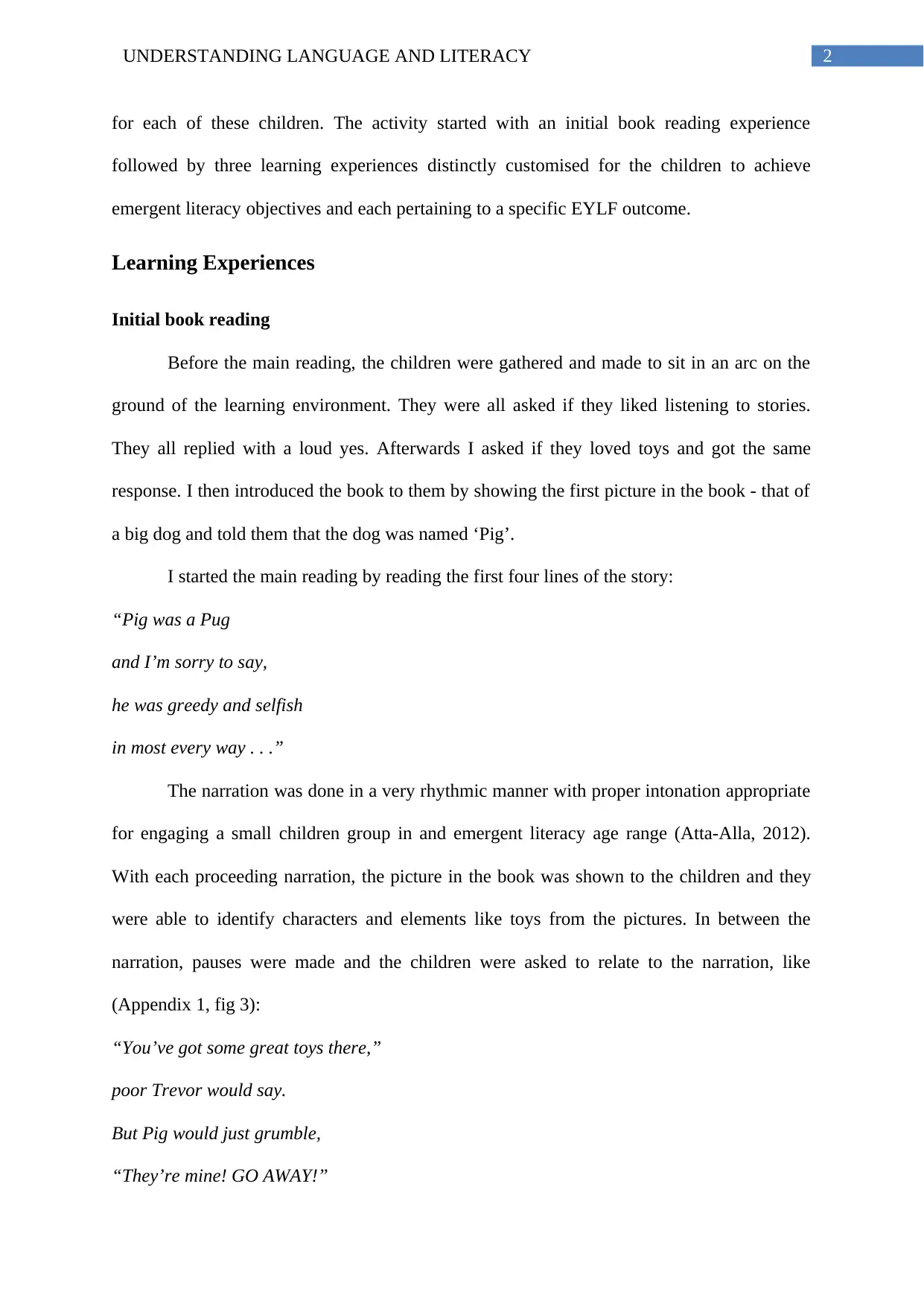
2UNDERSTANDING LANGUAGE AND LITERACY
for each of these children. The activity started with an initial book reading experience
followed by three learning experiences distinctly customised for the children to achieve
emergent literacy objectives and each pertaining to a specific EYLF outcome.
Learning Experiences
Initial book reading
Before the main reading, the children were gathered and made to sit in an arc on the
ground of the learning environment. They were all asked if they liked listening to stories.
They all replied with a loud yes. Afterwards I asked if they loved toys and got the same
response. I then introduced the book to them by showing the first picture in the book - that of
a big dog and told them that the dog was named ‘Pig’.
I started the main reading by reading the first four lines of the story:
“Pig was a Pug
and I’m sorry to say,
he was greedy and selfish
in most every way . . .”
The narration was done in a very rhythmic manner with proper intonation appropriate
for engaging a small children group in and emergent literacy age range (Atta-Alla, 2012).
With each proceeding narration, the picture in the book was shown to the children and they
were able to identify characters and elements like toys from the pictures. In between the
narration, pauses were made and the children were asked to relate to the narration, like
(Appendix 1, fig 3):
“You’ve got some great toys there,”
poor Trevor would say.
But Pig would just grumble,
“They’re mine! GO AWAY!”
for each of these children. The activity started with an initial book reading experience
followed by three learning experiences distinctly customised for the children to achieve
emergent literacy objectives and each pertaining to a specific EYLF outcome.
Learning Experiences
Initial book reading
Before the main reading, the children were gathered and made to sit in an arc on the
ground of the learning environment. They were all asked if they liked listening to stories.
They all replied with a loud yes. Afterwards I asked if they loved toys and got the same
response. I then introduced the book to them by showing the first picture in the book - that of
a big dog and told them that the dog was named ‘Pig’.
I started the main reading by reading the first four lines of the story:
“Pig was a Pug
and I’m sorry to say,
he was greedy and selfish
in most every way . . .”
The narration was done in a very rhythmic manner with proper intonation appropriate
for engaging a small children group in and emergent literacy age range (Atta-Alla, 2012).
With each proceeding narration, the picture in the book was shown to the children and they
were able to identify characters and elements like toys from the pictures. In between the
narration, pauses were made and the children were asked to relate to the narration, like
(Appendix 1, fig 3):
“You’ve got some great toys there,”
poor Trevor would say.
But Pig would just grumble,
“They’re mine! GO AWAY!”
⊘ This is a preview!⊘
Do you want full access?
Subscribe today to unlock all pages.

Trusted by 1+ million students worldwide
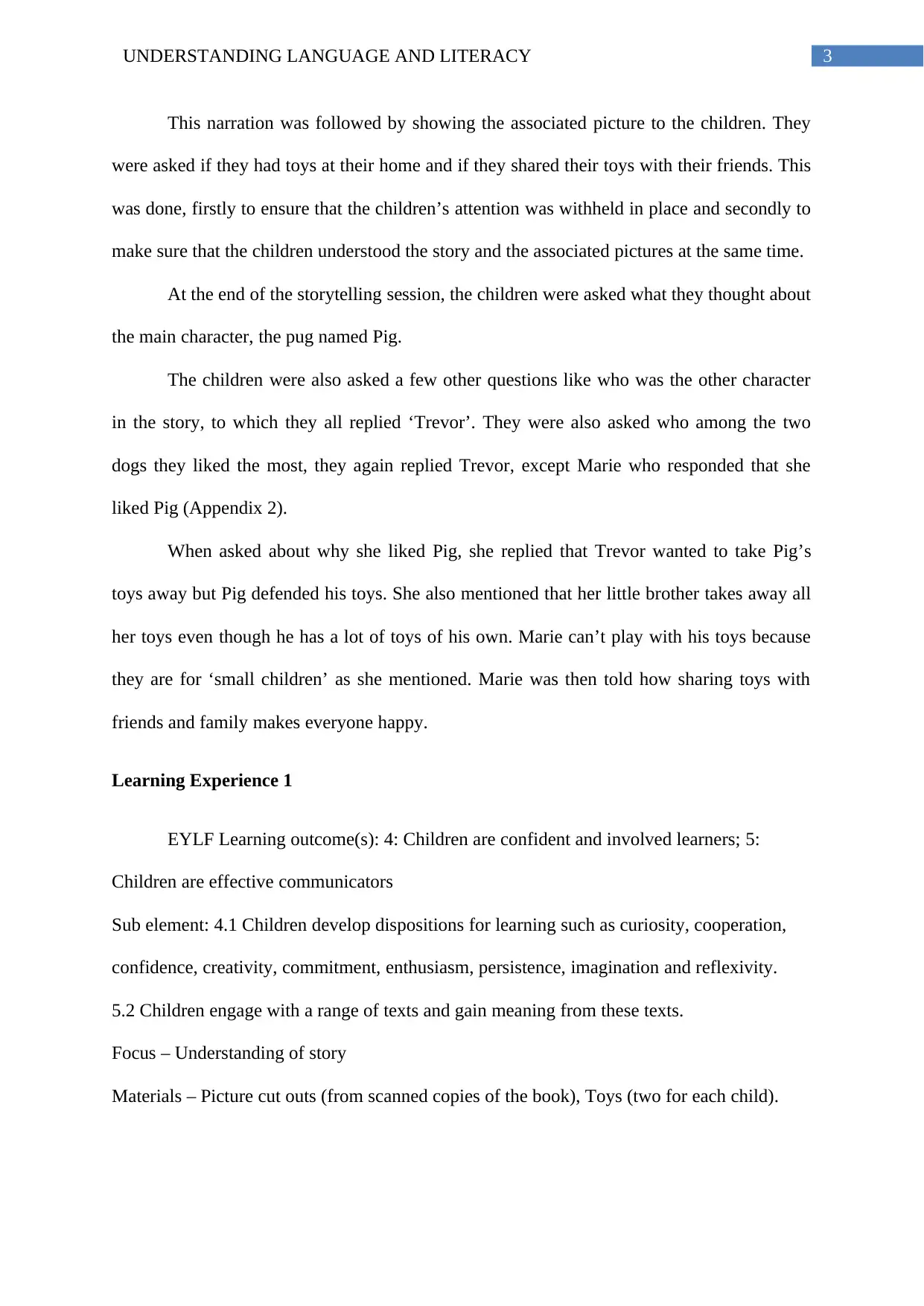
3UNDERSTANDING LANGUAGE AND LITERACY
This narration was followed by showing the associated picture to the children. They
were asked if they had toys at their home and if they shared their toys with their friends. This
was done, firstly to ensure that the children’s attention was withheld in place and secondly to
make sure that the children understood the story and the associated pictures at the same time.
At the end of the storytelling session, the children were asked what they thought about
the main character, the pug named Pig.
The children were also asked a few other questions like who was the other character
in the story, to which they all replied ‘Trevor’. They were also asked who among the two
dogs they liked the most, they again replied Trevor, except Marie who responded that she
liked Pig (Appendix 2).
When asked about why she liked Pig, she replied that Trevor wanted to take Pig’s
toys away but Pig defended his toys. She also mentioned that her little brother takes away all
her toys even though he has a lot of toys of his own. Marie can’t play with his toys because
they are for ‘small children’ as she mentioned. Marie was then told how sharing toys with
friends and family makes everyone happy.
Learning Experience 1
EYLF Learning outcome(s): 4: Children are confident and involved learners; 5:
Children are effective communicators
Sub element: 4.1 Children develop dispositions for learning such as curiosity, cooperation,
confidence, creativity, commitment, enthusiasm, persistence, imagination and reflexivity.
5.2 Children engage with a range of texts and gain meaning from these texts.
Focus – Understanding of story
Materials – Picture cut outs (from scanned copies of the book), Toys (two for each child).
This narration was followed by showing the associated picture to the children. They
were asked if they had toys at their home and if they shared their toys with their friends. This
was done, firstly to ensure that the children’s attention was withheld in place and secondly to
make sure that the children understood the story and the associated pictures at the same time.
At the end of the storytelling session, the children were asked what they thought about
the main character, the pug named Pig.
The children were also asked a few other questions like who was the other character
in the story, to which they all replied ‘Trevor’. They were also asked who among the two
dogs they liked the most, they again replied Trevor, except Marie who responded that she
liked Pig (Appendix 2).
When asked about why she liked Pig, she replied that Trevor wanted to take Pig’s
toys away but Pig defended his toys. She also mentioned that her little brother takes away all
her toys even though he has a lot of toys of his own. Marie can’t play with his toys because
they are for ‘small children’ as she mentioned. Marie was then told how sharing toys with
friends and family makes everyone happy.
Learning Experience 1
EYLF Learning outcome(s): 4: Children are confident and involved learners; 5:
Children are effective communicators
Sub element: 4.1 Children develop dispositions for learning such as curiosity, cooperation,
confidence, creativity, commitment, enthusiasm, persistence, imagination and reflexivity.
5.2 Children engage with a range of texts and gain meaning from these texts.
Focus – Understanding of story
Materials – Picture cut outs (from scanned copies of the book), Toys (two for each child).
Paraphrase This Document
Need a fresh take? Get an instant paraphrase of this document with our AI Paraphraser
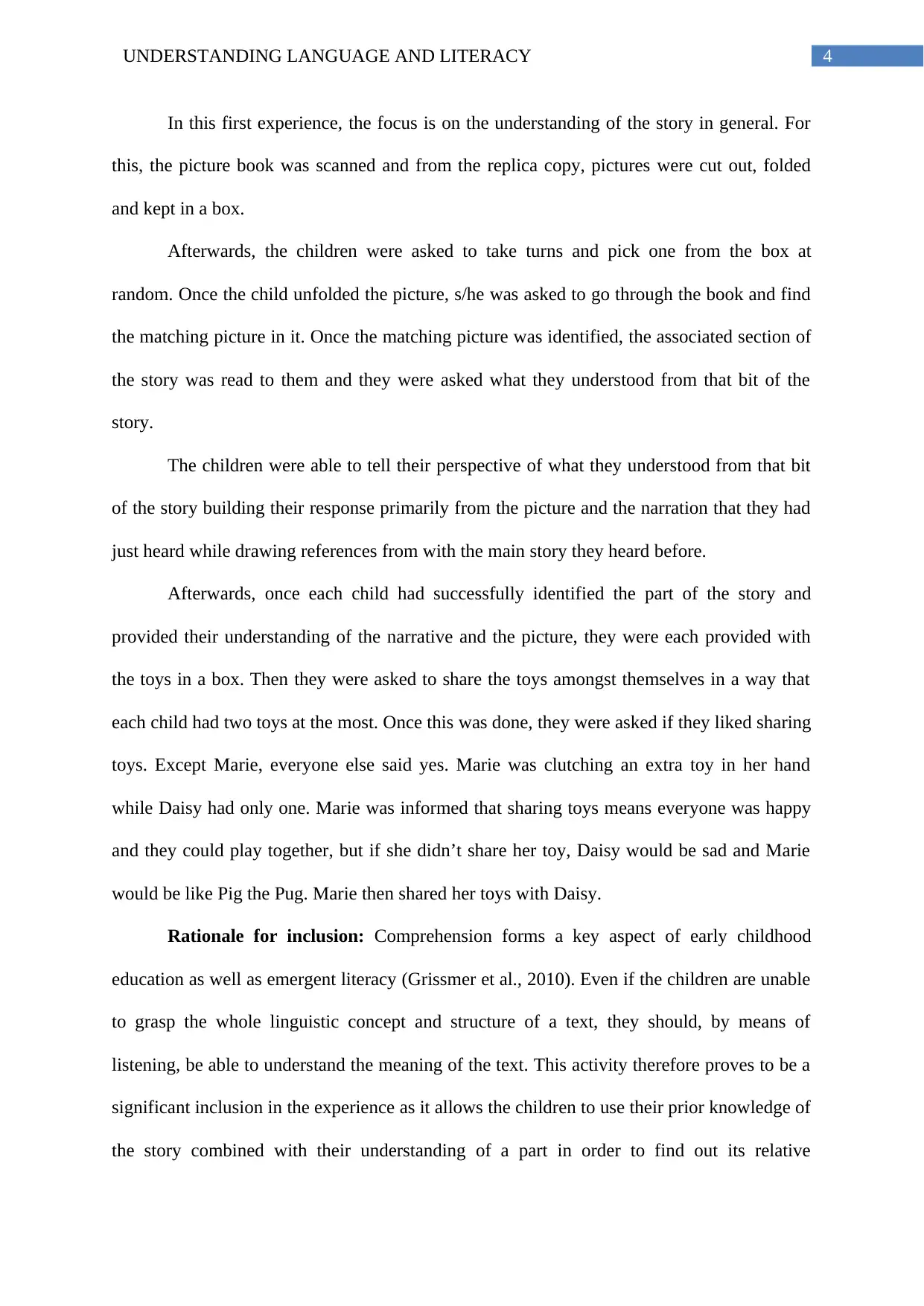
4UNDERSTANDING LANGUAGE AND LITERACY
In this first experience, the focus is on the understanding of the story in general. For
this, the picture book was scanned and from the replica copy, pictures were cut out, folded
and kept in a box.
Afterwards, the children were asked to take turns and pick one from the box at
random. Once the child unfolded the picture, s/he was asked to go through the book and find
the matching picture in it. Once the matching picture was identified, the associated section of
the story was read to them and they were asked what they understood from that bit of the
story.
The children were able to tell their perspective of what they understood from that bit
of the story building their response primarily from the picture and the narration that they had
just heard while drawing references from with the main story they heard before.
Afterwards, once each child had successfully identified the part of the story and
provided their understanding of the narrative and the picture, they were each provided with
the toys in a box. Then they were asked to share the toys amongst themselves in a way that
each child had two toys at the most. Once this was done, they were asked if they liked sharing
toys. Except Marie, everyone else said yes. Marie was clutching an extra toy in her hand
while Daisy had only one. Marie was informed that sharing toys means everyone was happy
and they could play together, but if she didn’t share her toy, Daisy would be sad and Marie
would be like Pig the Pug. Marie then shared her toys with Daisy.
Rationale for inclusion: Comprehension forms a key aspect of early childhood
education as well as emergent literacy (Grissmer et al., 2010). Even if the children are unable
to grasp the whole linguistic concept and structure of a text, they should, by means of
listening, be able to understand the meaning of the text. This activity therefore proves to be a
significant inclusion in the experience as it allows the children to use their prior knowledge of
the story combined with their understanding of a part in order to find out its relative
In this first experience, the focus is on the understanding of the story in general. For
this, the picture book was scanned and from the replica copy, pictures were cut out, folded
and kept in a box.
Afterwards, the children were asked to take turns and pick one from the box at
random. Once the child unfolded the picture, s/he was asked to go through the book and find
the matching picture in it. Once the matching picture was identified, the associated section of
the story was read to them and they were asked what they understood from that bit of the
story.
The children were able to tell their perspective of what they understood from that bit
of the story building their response primarily from the picture and the narration that they had
just heard while drawing references from with the main story they heard before.
Afterwards, once each child had successfully identified the part of the story and
provided their understanding of the narrative and the picture, they were each provided with
the toys in a box. Then they were asked to share the toys amongst themselves in a way that
each child had two toys at the most. Once this was done, they were asked if they liked sharing
toys. Except Marie, everyone else said yes. Marie was clutching an extra toy in her hand
while Daisy had only one. Marie was informed that sharing toys means everyone was happy
and they could play together, but if she didn’t share her toy, Daisy would be sad and Marie
would be like Pig the Pug. Marie then shared her toys with Daisy.
Rationale for inclusion: Comprehension forms a key aspect of early childhood
education as well as emergent literacy (Grissmer et al., 2010). Even if the children are unable
to grasp the whole linguistic concept and structure of a text, they should, by means of
listening, be able to understand the meaning of the text. This activity therefore proves to be a
significant inclusion in the experience as it allows the children to use their prior knowledge of
the story combined with their understanding of a part in order to find out its relative
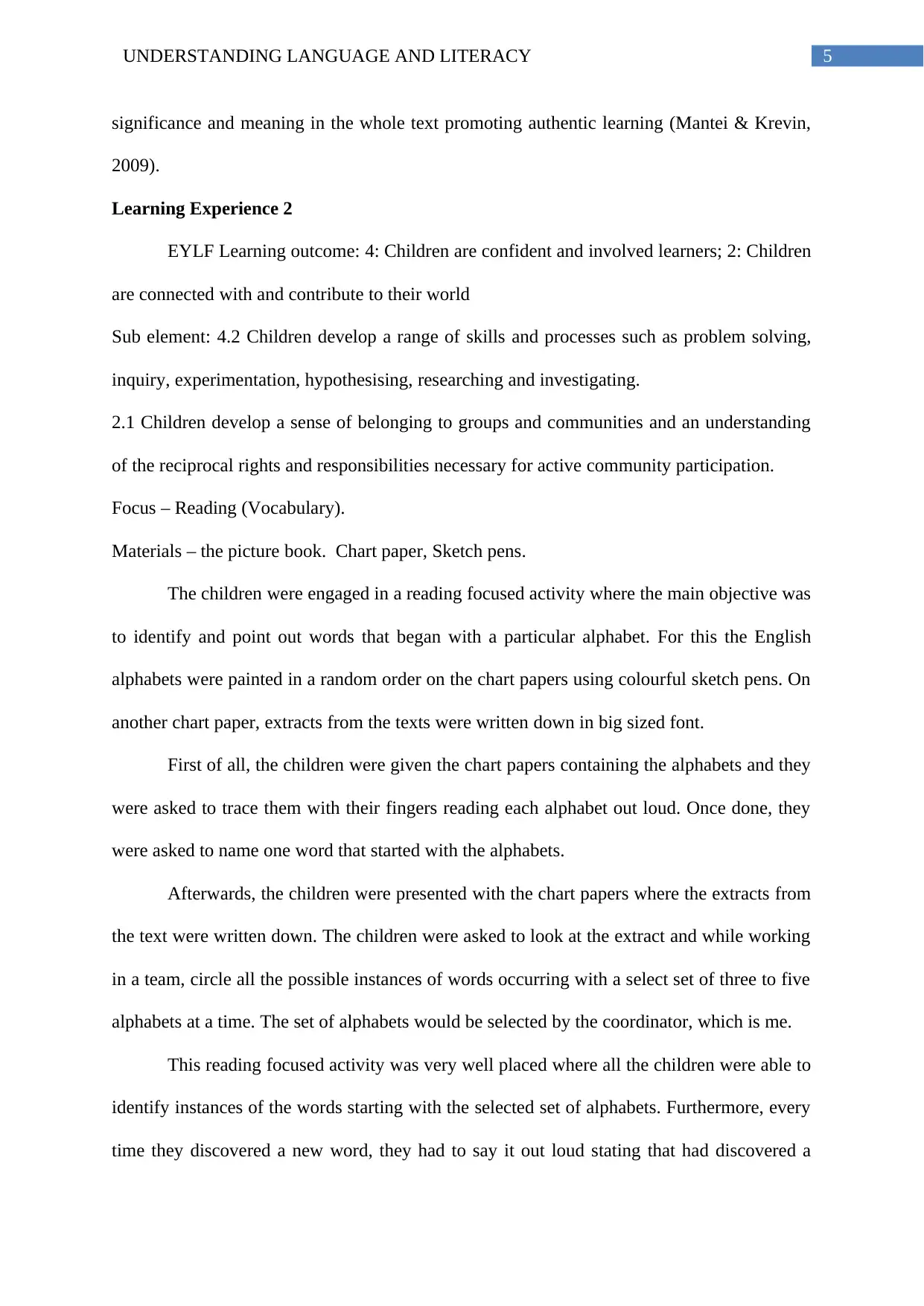
5UNDERSTANDING LANGUAGE AND LITERACY
significance and meaning in the whole text promoting authentic learning (Mantei & Krevin,
2009).
Learning Experience 2
EYLF Learning outcome: 4: Children are confident and involved learners; 2: Children
are connected with and contribute to their world
Sub element: 4.2 Children develop a range of skills and processes such as problem solving,
inquiry, experimentation, hypothesising, researching and investigating.
2.1 Children develop a sense of belonging to groups and communities and an understanding
of the reciprocal rights and responsibilities necessary for active community participation.
Focus – Reading (Vocabulary).
Materials – the picture book. Chart paper, Sketch pens.
The children were engaged in a reading focused activity where the main objective was
to identify and point out words that began with a particular alphabet. For this the English
alphabets were painted in a random order on the chart papers using colourful sketch pens. On
another chart paper, extracts from the texts were written down in big sized font.
First of all, the children were given the chart papers containing the alphabets and they
were asked to trace them with their fingers reading each alphabet out loud. Once done, they
were asked to name one word that started with the alphabets.
Afterwards, the children were presented with the chart papers where the extracts from
the text were written down. The children were asked to look at the extract and while working
in a team, circle all the possible instances of words occurring with a select set of three to five
alphabets at a time. The set of alphabets would be selected by the coordinator, which is me.
This reading focused activity was very well placed where all the children were able to
identify instances of the words starting with the selected set of alphabets. Furthermore, every
time they discovered a new word, they had to say it out loud stating that had discovered a
significance and meaning in the whole text promoting authentic learning (Mantei & Krevin,
2009).
Learning Experience 2
EYLF Learning outcome: 4: Children are confident and involved learners; 2: Children
are connected with and contribute to their world
Sub element: 4.2 Children develop a range of skills and processes such as problem solving,
inquiry, experimentation, hypothesising, researching and investigating.
2.1 Children develop a sense of belonging to groups and communities and an understanding
of the reciprocal rights and responsibilities necessary for active community participation.
Focus – Reading (Vocabulary).
Materials – the picture book. Chart paper, Sketch pens.
The children were engaged in a reading focused activity where the main objective was
to identify and point out words that began with a particular alphabet. For this the English
alphabets were painted in a random order on the chart papers using colourful sketch pens. On
another chart paper, extracts from the texts were written down in big sized font.
First of all, the children were given the chart papers containing the alphabets and they
were asked to trace them with their fingers reading each alphabet out loud. Once done, they
were asked to name one word that started with the alphabets.
Afterwards, the children were presented with the chart papers where the extracts from
the text were written down. The children were asked to look at the extract and while working
in a team, circle all the possible instances of words occurring with a select set of three to five
alphabets at a time. The set of alphabets would be selected by the coordinator, which is me.
This reading focused activity was very well placed where all the children were able to
identify instances of the words starting with the selected set of alphabets. Furthermore, every
time they discovered a new word, they had to say it out loud stating that had discovered a
⊘ This is a preview!⊘
Do you want full access?
Subscribe today to unlock all pages.

Trusted by 1+ million students worldwide
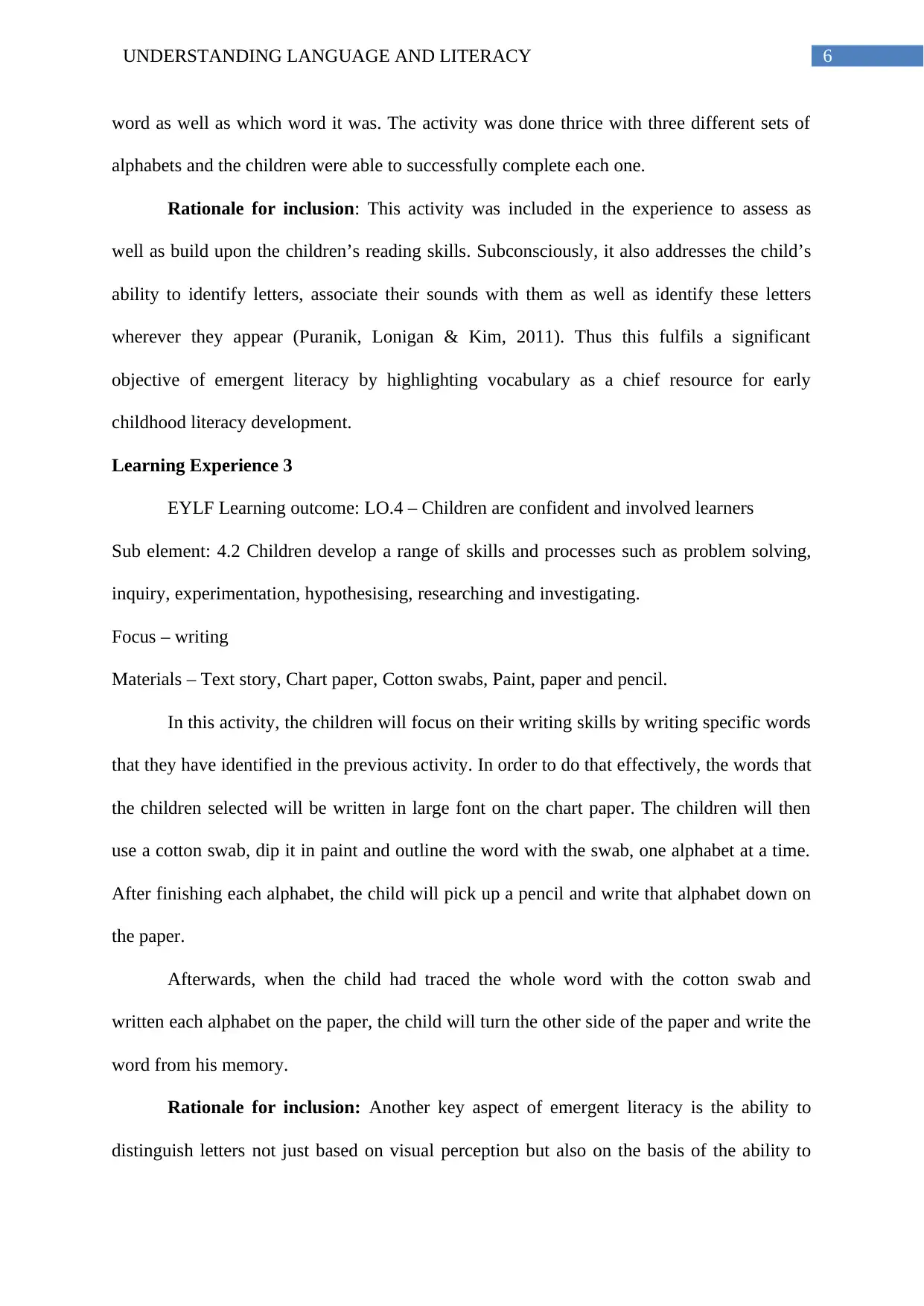
6UNDERSTANDING LANGUAGE AND LITERACY
word as well as which word it was. The activity was done thrice with three different sets of
alphabets and the children were able to successfully complete each one.
Rationale for inclusion: This activity was included in the experience to assess as
well as build upon the children’s reading skills. Subconsciously, it also addresses the child’s
ability to identify letters, associate their sounds with them as well as identify these letters
wherever they appear (Puranik, Lonigan & Kim, 2011). Thus this fulfils a significant
objective of emergent literacy by highlighting vocabulary as a chief resource for early
childhood literacy development.
Learning Experience 3
EYLF Learning outcome: LO.4 – Children are confident and involved learners
Sub element: 4.2 Children develop a range of skills and processes such as problem solving,
inquiry, experimentation, hypothesising, researching and investigating.
Focus – writing
Materials – Text story, Chart paper, Cotton swabs, Paint, paper and pencil.
In this activity, the children will focus on their writing skills by writing specific words
that they have identified in the previous activity. In order to do that effectively, the words that
the children selected will be written in large font on the chart paper. The children will then
use a cotton swab, dip it in paint and outline the word with the swab, one alphabet at a time.
After finishing each alphabet, the child will pick up a pencil and write that alphabet down on
the paper.
Afterwards, when the child had traced the whole word with the cotton swab and
written each alphabet on the paper, the child will turn the other side of the paper and write the
word from his memory.
Rationale for inclusion: Another key aspect of emergent literacy is the ability to
distinguish letters not just based on visual perception but also on the basis of the ability to
word as well as which word it was. The activity was done thrice with three different sets of
alphabets and the children were able to successfully complete each one.
Rationale for inclusion: This activity was included in the experience to assess as
well as build upon the children’s reading skills. Subconsciously, it also addresses the child’s
ability to identify letters, associate their sounds with them as well as identify these letters
wherever they appear (Puranik, Lonigan & Kim, 2011). Thus this fulfils a significant
objective of emergent literacy by highlighting vocabulary as a chief resource for early
childhood literacy development.
Learning Experience 3
EYLF Learning outcome: LO.4 – Children are confident and involved learners
Sub element: 4.2 Children develop a range of skills and processes such as problem solving,
inquiry, experimentation, hypothesising, researching and investigating.
Focus – writing
Materials – Text story, Chart paper, Cotton swabs, Paint, paper and pencil.
In this activity, the children will focus on their writing skills by writing specific words
that they have identified in the previous activity. In order to do that effectively, the words that
the children selected will be written in large font on the chart paper. The children will then
use a cotton swab, dip it in paint and outline the word with the swab, one alphabet at a time.
After finishing each alphabet, the child will pick up a pencil and write that alphabet down on
the paper.
Afterwards, when the child had traced the whole word with the cotton swab and
written each alphabet on the paper, the child will turn the other side of the paper and write the
word from his memory.
Rationale for inclusion: Another key aspect of emergent literacy is the ability to
distinguish letters not just based on visual perception but also on the basis of the ability to
Paraphrase This Document
Need a fresh take? Get an instant paraphrase of this document with our AI Paraphraser
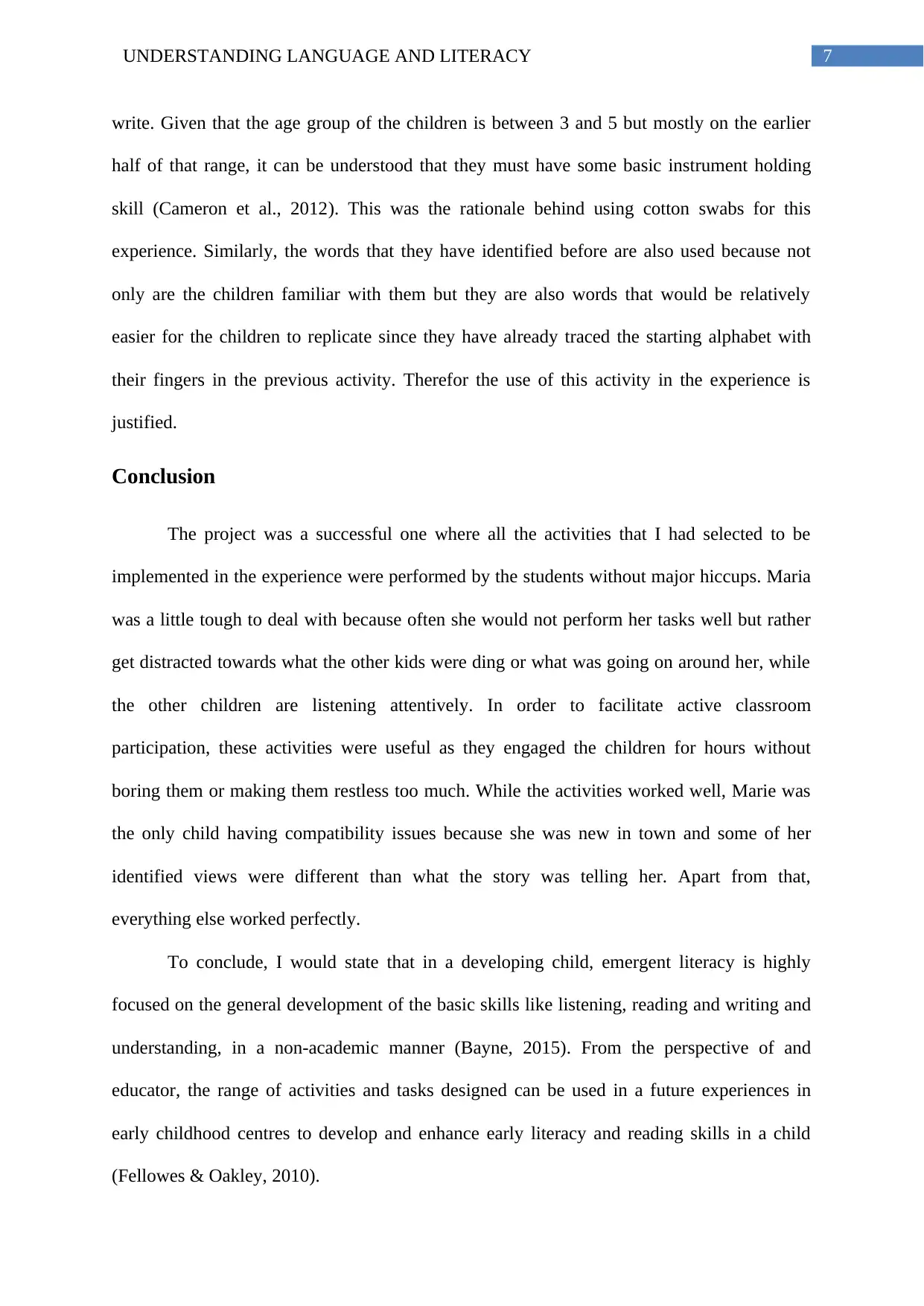
7UNDERSTANDING LANGUAGE AND LITERACY
write. Given that the age group of the children is between 3 and 5 but mostly on the earlier
half of that range, it can be understood that they must have some basic instrument holding
skill (Cameron et al., 2012). This was the rationale behind using cotton swabs for this
experience. Similarly, the words that they have identified before are also used because not
only are the children familiar with them but they are also words that would be relatively
easier for the children to replicate since they have already traced the starting alphabet with
their fingers in the previous activity. Therefor the use of this activity in the experience is
justified.
Conclusion
The project was a successful one where all the activities that I had selected to be
implemented in the experience were performed by the students without major hiccups. Maria
was a little tough to deal with because often she would not perform her tasks well but rather
get distracted towards what the other kids were ding or what was going on around her, while
the other children are listening attentively. In order to facilitate active classroom
participation, these activities were useful as they engaged the children for hours without
boring them or making them restless too much. While the activities worked well, Marie was
the only child having compatibility issues because she was new in town and some of her
identified views were different than what the story was telling her. Apart from that,
everything else worked perfectly.
To conclude, I would state that in a developing child, emergent literacy is highly
focused on the general development of the basic skills like listening, reading and writing and
understanding, in a non-academic manner (Bayne, 2015). From the perspective of and
educator, the range of activities and tasks designed can be used in a future experiences in
early childhood centres to develop and enhance early literacy and reading skills in a child
(Fellowes & Oakley, 2010).
write. Given that the age group of the children is between 3 and 5 but mostly on the earlier
half of that range, it can be understood that they must have some basic instrument holding
skill (Cameron et al., 2012). This was the rationale behind using cotton swabs for this
experience. Similarly, the words that they have identified before are also used because not
only are the children familiar with them but they are also words that would be relatively
easier for the children to replicate since they have already traced the starting alphabet with
their fingers in the previous activity. Therefor the use of this activity in the experience is
justified.
Conclusion
The project was a successful one where all the activities that I had selected to be
implemented in the experience were performed by the students without major hiccups. Maria
was a little tough to deal with because often she would not perform her tasks well but rather
get distracted towards what the other kids were ding or what was going on around her, while
the other children are listening attentively. In order to facilitate active classroom
participation, these activities were useful as they engaged the children for hours without
boring them or making them restless too much. While the activities worked well, Marie was
the only child having compatibility issues because she was new in town and some of her
identified views were different than what the story was telling her. Apart from that,
everything else worked perfectly.
To conclude, I would state that in a developing child, emergent literacy is highly
focused on the general development of the basic skills like listening, reading and writing and
understanding, in a non-academic manner (Bayne, 2015). From the perspective of and
educator, the range of activities and tasks designed can be used in a future experiences in
early childhood centres to develop and enhance early literacy and reading skills in a child
(Fellowes & Oakley, 2010).
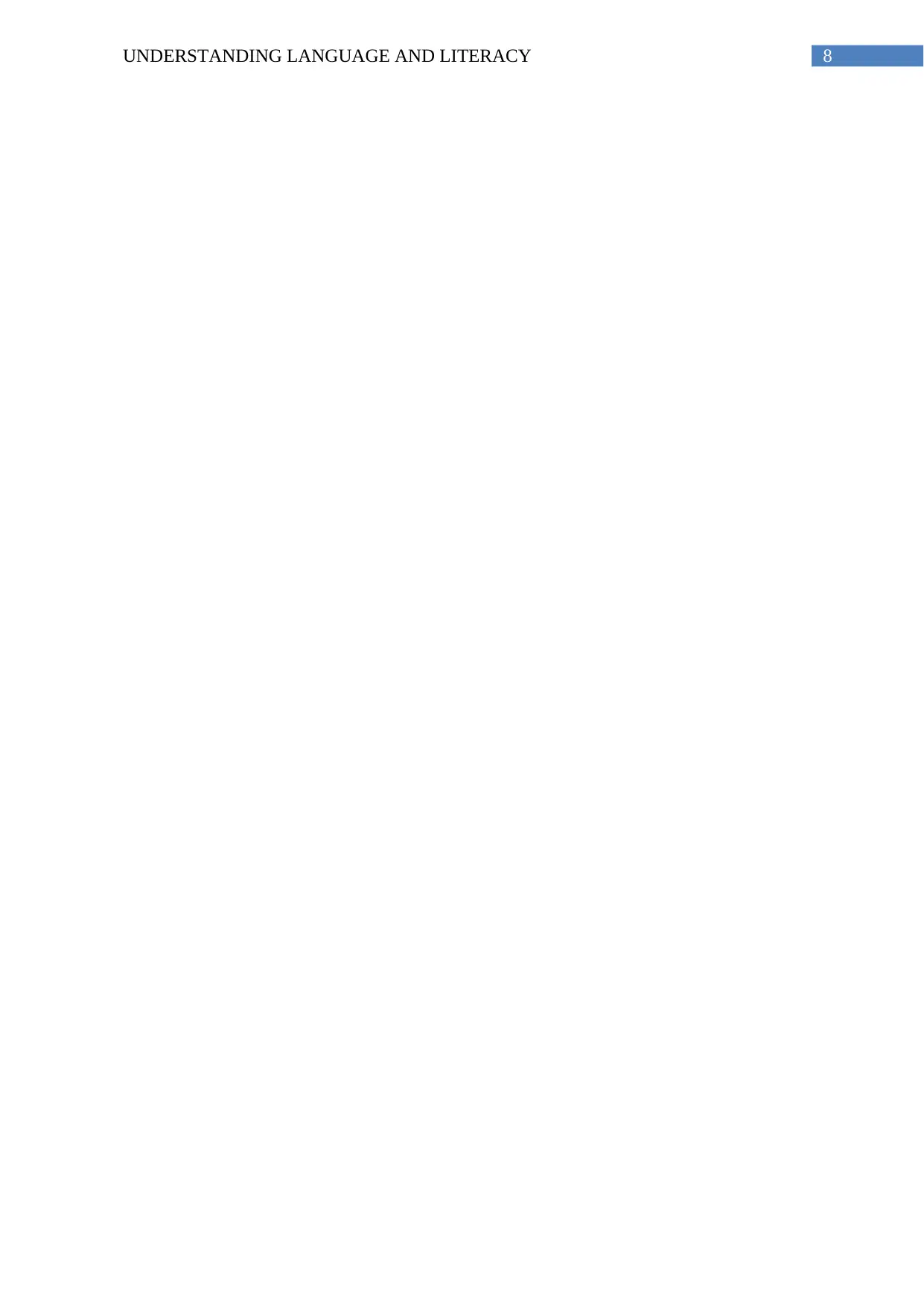
8UNDERSTANDING LANGUAGE AND LITERACY
⊘ This is a preview!⊘
Do you want full access?
Subscribe today to unlock all pages.

Trusted by 1+ million students worldwide
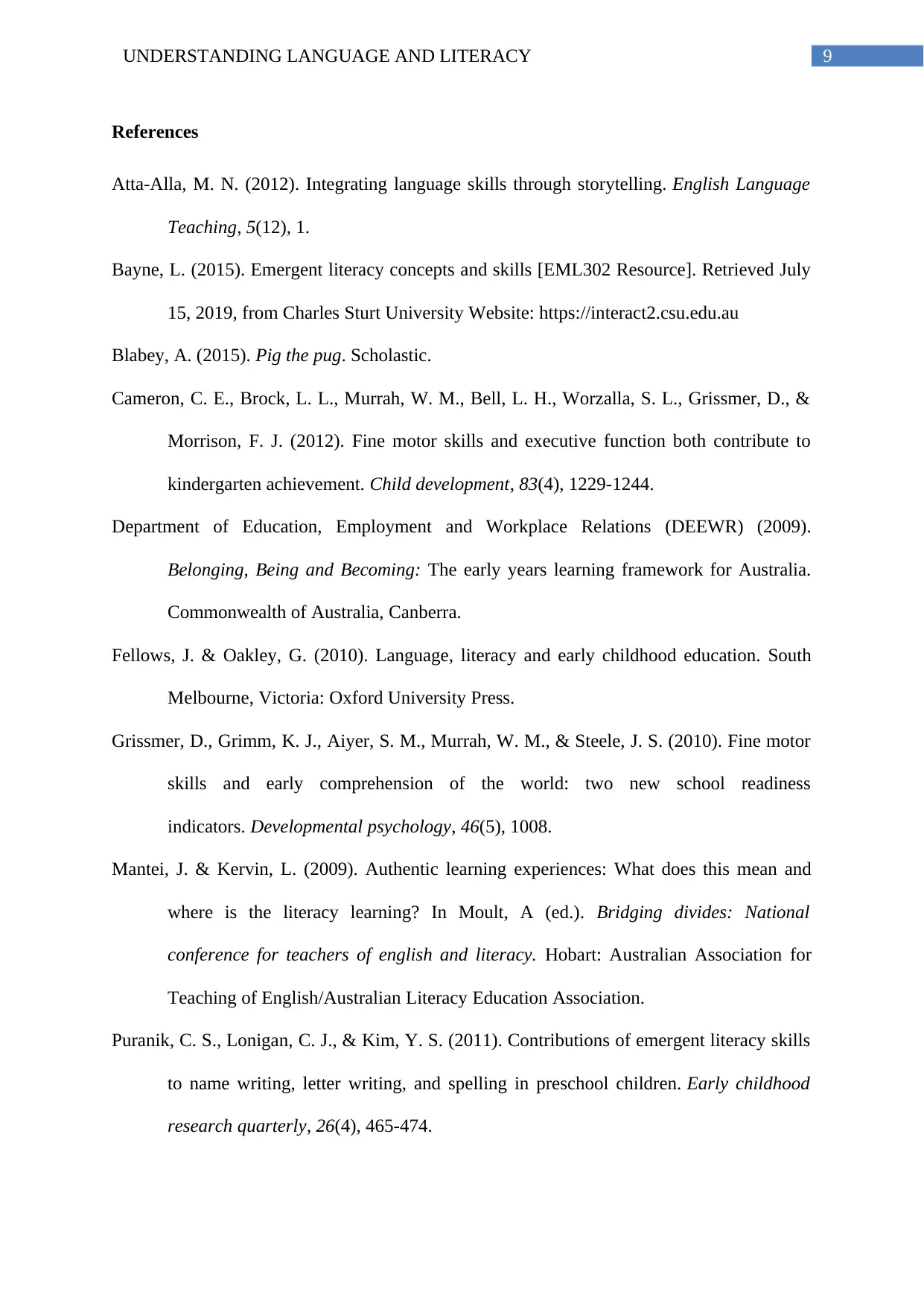
9UNDERSTANDING LANGUAGE AND LITERACY
References
Atta-Alla, M. N. (2012). Integrating language skills through storytelling. English Language
Teaching, 5(12), 1.
Bayne, L. (2015). Emergent literacy concepts and skills [EML302 Resource]. Retrieved July
15, 2019, from Charles Sturt University Website: https://interact2.csu.edu.au
Blabey, A. (2015). Pig the pug. Scholastic.
Cameron, C. E., Brock, L. L., Murrah, W. M., Bell, L. H., Worzalla, S. L., Grissmer, D., &
Morrison, F. J. (2012). Fine motor skills and executive function both contribute to
kindergarten achievement. Child development, 83(4), 1229-1244.
Department of Education, Employment and Workplace Relations (DEEWR) (2009).
Belonging, Being and Becoming: The early years learning framework for Australia.
Commonwealth of Australia, Canberra.
Fellows, J. & Oakley, G. (2010). Language, literacy and early childhood education. South
Melbourne, Victoria: Oxford University Press.
Grissmer, D., Grimm, K. J., Aiyer, S. M., Murrah, W. M., & Steele, J. S. (2010). Fine motor
skills and early comprehension of the world: two new school readiness
indicators. Developmental psychology, 46(5), 1008.
Mantei, J. & Kervin, L. (2009). Authentic learning experiences: What does this mean and
where is the literacy learning? In Moult, A (ed.). Bridging divides: National
conference for teachers of english and literacy. Hobart: Australian Association for
Teaching of English/Australian Literacy Education Association.
Puranik, C. S., Lonigan, C. J., & Kim, Y. S. (2011). Contributions of emergent literacy skills
to name writing, letter writing, and spelling in preschool children. Early childhood
research quarterly, 26(4), 465-474.
References
Atta-Alla, M. N. (2012). Integrating language skills through storytelling. English Language
Teaching, 5(12), 1.
Bayne, L. (2015). Emergent literacy concepts and skills [EML302 Resource]. Retrieved July
15, 2019, from Charles Sturt University Website: https://interact2.csu.edu.au
Blabey, A. (2015). Pig the pug. Scholastic.
Cameron, C. E., Brock, L. L., Murrah, W. M., Bell, L. H., Worzalla, S. L., Grissmer, D., &
Morrison, F. J. (2012). Fine motor skills and executive function both contribute to
kindergarten achievement. Child development, 83(4), 1229-1244.
Department of Education, Employment and Workplace Relations (DEEWR) (2009).
Belonging, Being and Becoming: The early years learning framework for Australia.
Commonwealth of Australia, Canberra.
Fellows, J. & Oakley, G. (2010). Language, literacy and early childhood education. South
Melbourne, Victoria: Oxford University Press.
Grissmer, D., Grimm, K. J., Aiyer, S. M., Murrah, W. M., & Steele, J. S. (2010). Fine motor
skills and early comprehension of the world: two new school readiness
indicators. Developmental psychology, 46(5), 1008.
Mantei, J. & Kervin, L. (2009). Authentic learning experiences: What does this mean and
where is the literacy learning? In Moult, A (ed.). Bridging divides: National
conference for teachers of english and literacy. Hobart: Australian Association for
Teaching of English/Australian Literacy Education Association.
Puranik, C. S., Lonigan, C. J., & Kim, Y. S. (2011). Contributions of emergent literacy skills
to name writing, letter writing, and spelling in preschool children. Early childhood
research quarterly, 26(4), 465-474.
Paraphrase This Document
Need a fresh take? Get an instant paraphrase of this document with our AI Paraphraser
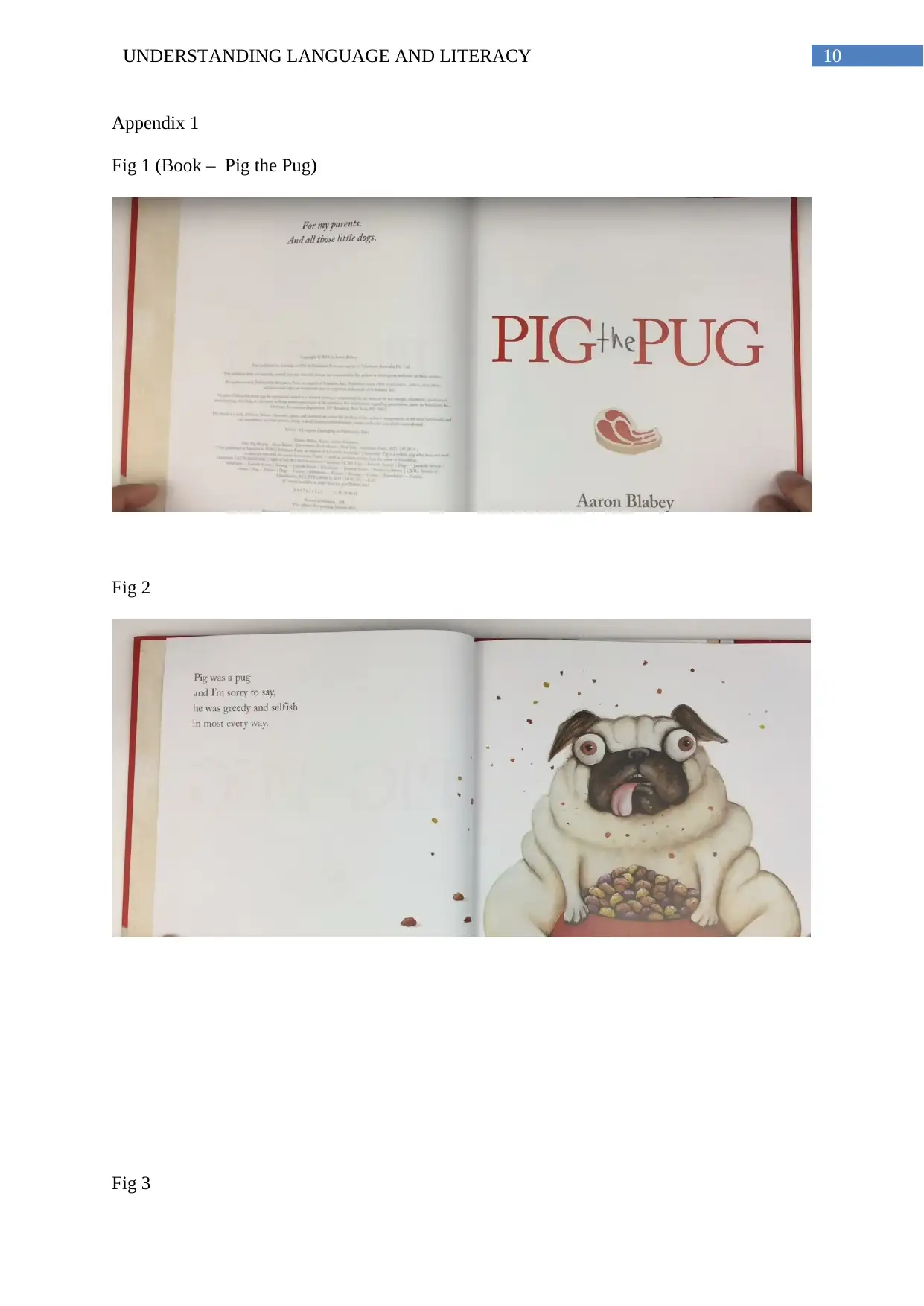
10UNDERSTANDING LANGUAGE AND LITERACY
Appendix 1
Fig 1 (Book – Pig the Pug)
Fig 2
Fig 3
Appendix 1
Fig 1 (Book – Pig the Pug)
Fig 2
Fig 3
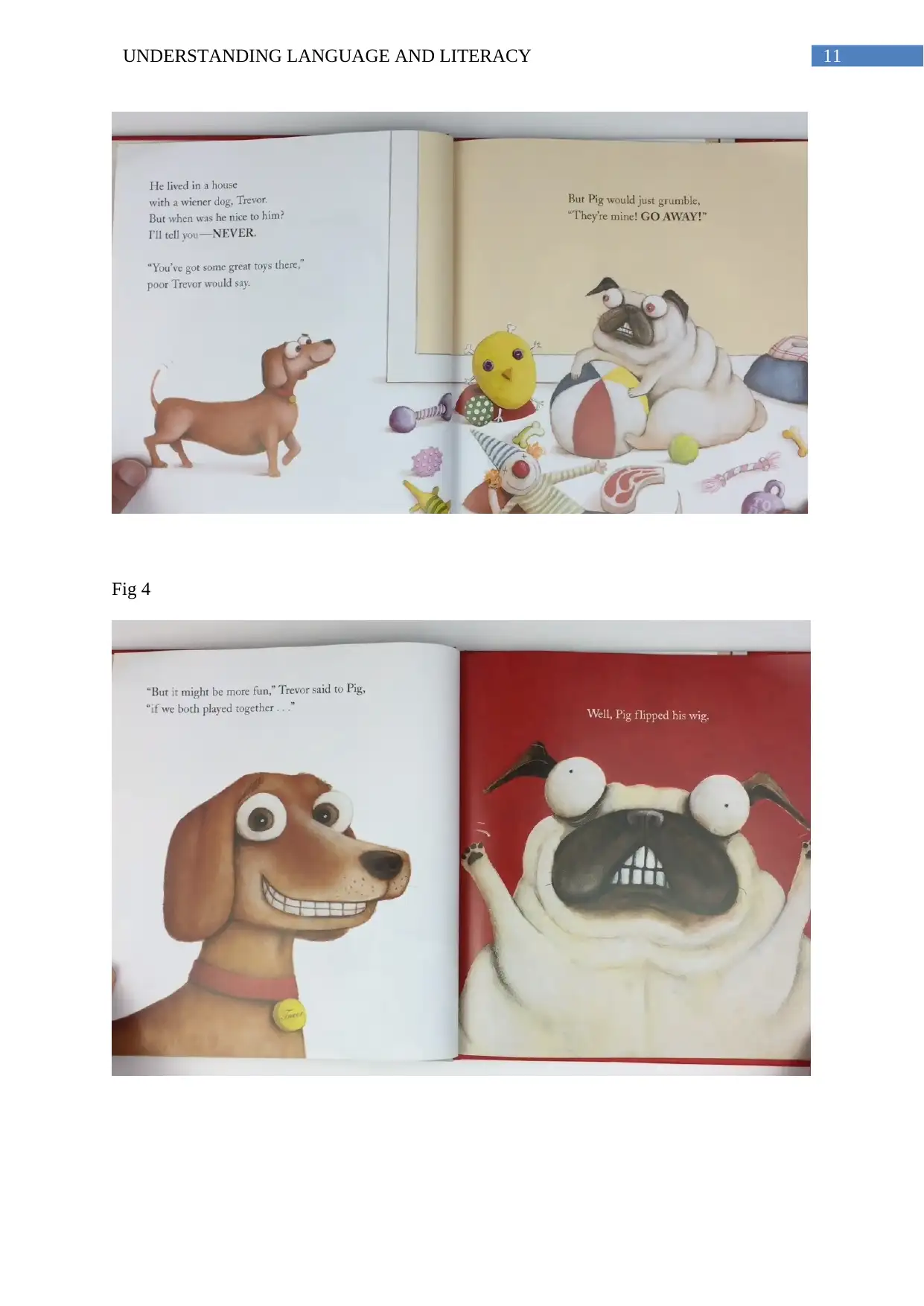
11UNDERSTANDING LANGUAGE AND LITERACY
Fig 4
Fig 4
⊘ This is a preview!⊘
Do you want full access?
Subscribe today to unlock all pages.

Trusted by 1+ million students worldwide
1 out of 12
Your All-in-One AI-Powered Toolkit for Academic Success.
+13062052269
info@desklib.com
Available 24*7 on WhatsApp / Email
![[object Object]](/_next/static/media/star-bottom.7253800d.svg)
Unlock your academic potential
Copyright © 2020–2025 A2Z Services. All Rights Reserved. Developed and managed by ZUCOL.